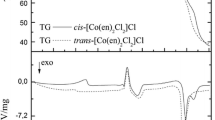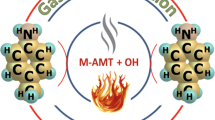Abstract
The reactivity of aryl cations toward molecular nitrogen is studied systematically in an ion trap mass spectrometer at 102 Pascal of nitrogen, the pressure of the Titan main haze layer. Nucleophilic addition of dinitrogen occurs and the nature of aryl group has a significant influence on the reactivity, through inductive effects and by changing the ground state spin multiplicity. The products of nitrogen activation, aryldiazonium ions, react with typical nitriles, aromatic amines, and alkynes (compounds that are relevant as possible Titan atmosphere constituents) to form covalently bonded heterocyclic products. Theoretical calculations at the level [DFT(B3LYP)/6-311++G(d,p)] indicate that the N2 addition reaction is exothermic for the singlet aryl cations but endothermic for their triplet spin isomers. The –OH and –NH2 substituted aryl ions are calculated to have triplet ground states, which is consistent with their decreased nitrogen addition reactivity. The energy needed for the generation of the aryl cations from their protonated precursors (ca. 340 kJ/mol starting with protonated aniline) is far less than that required to directly activate the nitrogen triple bond (the lowest energy excited state of N2 lies ca. 600 kJ/mol above the ground state). The formation of aza-aromatics via arene ionization and subsequent reactions provide a conceivable route to the genesis of nitrogen-containing organic molecules in the interstellar medium and Titan haze layers.

ᅟ






Similar content being viewed by others
References
Ertl, G.: Primary steps in catalytic synthesis of ammonia. J. Vac. Sci. Technol. A 1, 1247–1253 (1983)
Yandulov, D.V., Schrock, R.R.: Catalytic reduction of dinitrogen to ammonia at a single molybdenum center. Science 301, 76–78 (2003)
Arashiba, K., Miyake, Y., Nishibayashi, Y.: A molybdenum complex bearing pnp-type pincer ligands leads to the catalytic reduction of dinitrogen into ammonia. Nat. Chem. 3, 120–125 (2011)
Cleaves, H.J., Chalmers, J.H., Lazcano, A., Miller, S.L., Bada, J.L.: A reassessment of prebiotic organic synthesis in neutral planetary atmospheres. Orig. Life Evol. Biosph. 38, 105–115 (2008)
Trainer, M.G., Pavlov, A.A., DeWitt, H.L., Jimenez, J.L., McKay, C.P., Toon, O.B., Tolbert, M.A.: Organic haze on Titan and the early earth. Proc. Natl. Acad. Sci. U. S. A. 103, 18035–18042 (2006)
Schmitt-Kopplin, P., Gabelica, Z., Gougeon, R.D., Fekete, A., Kanawati, B., Harir, M., Gebefuegi, I., Eckel, G., Hertkorn, N.: High molecular diversity of extraterrestrial organic matter in murchison meteorite revealed 40 years after its fall. Proc. Natl. Acad. Sci. U. S. A. 107, 2763–2768 (2010)
Ehrenfreund, P., Charnley, S.B.: Organic molecules in the interstellar medium, comets, and meteorites: a voyage from dark clouds to the early earth. Ann. Rev. Astronomy Astrophys. 38, 427–483 (2000)
Cravens, T.E., Robertson, I.P., Waite, J.H., Yelle, R.V., Kasprzak, W.T., Keller, C.N., Ledvina, S.A., Niemann, H.B., Luhmann, J.G., McNutt, R.L., Ip, W.H., De La Haye, V., Mueller-Wodarg, I., Wahlund, J.E., Anicich, V.G., Vuitton, V.: Composition of Titan's ionosphere. Geophys. Res. Lett. 33 (2006)
Waite, J.H., Young, D.T., Cravens, T.E., Coates, A.J., Crary, F.J., Magee, B., Westlake, J.: The process of tholin formation in Titan’s upper atmosphere. Science 316, 870–875 (2007)
Galand, M., Yelle, R.V., Coates, A.J., Backes, H., Wahlund, J.E.: Electron temperature of Titan's sunlit ionosphere. Geophys. Res. Lett. 33 (2006)
Vuitton, V., Yelle, R.V., Anicich, V.G.: The nitrogen chemistry of Titan’s upper atmosphere revealed. Astrophys. J. 647, L175–L178 (2006)
Trainer, M.G., Sebree, J.A., Yoon, Y.H., Tolbert, M.A.: The influence of benzene as a trace reactant in Titan aerosol analogs. Astrophys. J. Lett. 766, L4 (2013)
Imanaka, H., Smith, M.A.: Euv photochemical production of unsaturated hydrocarbons: implications to euv photochemistry in Titan and Jovian planets. J. Phys. Chem. A 113, 11187–11194 (2009)
Thissen, R., Vuitton, V., Lavvas, P., Lemaire, J., Dehon, C., Dutuit, O., Smith, M.A., Turchini, S., Catone, D., Yelle, R.V., Pernot, P., Somogyi, A., Coreno, M.: Laboratory studies of molecular growth in the Titan ionosphere. J. Phys. Chem. A 113, 11211–11220 (2009)
Somogyi, Á., Smith, M.A., Vuitton, V., Thissen, R., Komáromi, I.: Chemical ionization in the atmosphere? A model study on negatively charged “exotic” ions generated from Titan’s tholins by ultrahigh resolution ms and MS/MS. Int. J. Mass Spectrom 316/318, 157–163 (2012)
Pernot, P., Carrasco, N., Thissen, R., Schmitz-Afonso, I.: Tholinomics-chemical analysis of nitrogen-rich polymers. Anal. Chem. 82, 1371–1380 (2010)
Imanaka, H., Cruikshank, D.P., Khare, B.N., McKay, C.P.: Optical constants of Titan tholins at mid-infrared wavelengths (2.5–25 mu m) and the possible chemical nature of Titan’s haze particles. Icarus 218, 247–261 (2012)
Thompson, W.R., Mcdonald, G.D., Sagan, C.: The Titan haze revisited: magnetospheric energy sources and quantitative tholin yields. Icarus 112, 376–381 (1994)
Ramirez, S.I., Navarro-Gonzalez, R., Coll, P., Raulin, F.: Possible contribution of different energy sources to the production of organics in Titan’s atmosphere. Adv. Space Res. 27, 261–270 (2001)
Penz, T., Lammer, H., Kulikov, Y.N., Biernat, H.K.: The influence of the solar particle and radiation environment on Titan’s atmosphere evolution. Adv. Space Res. 36, 241–250 (2005)
Cable, M.L., Horst, S.M., Hodyss, R., Beauchamp, P.M., Smith, M.A., Willis, P.A.: Titan tholins: simulating Titan organic chemistry in the Cassini-Huygens era. Chem. Rev. 112, 1882–1909 (2012)
Shilov, A.E., Shteinman, A.A., Tjabin, M.B.: Reaction of carbenes with molecular nitrogen. Tetrahedron Lett. 9, 4177–4180 (1968)
Bergstrom, R.G., Landells, R.G.M., Wahl, G.H., Zollinger, H.: Dediazoniation of arenediazonium ions in homogeneous solution. 7. Intermediacy of the phenyl cation. J. Am. Chem. Soc. 98, 3301–3305 (1976)
Guella, G., Ascenzi, D., Franceschi, P., Tosi, P.: Gas-phase synthesis and detection of the benzenediazonium ion, c6h5n2+. A joint atmospheric pressure chemical ionization and guided ion beam experiment. Rapid Commun. J. Am. Chem. Soc.Mass Spectrom. 19, 1951–1955 (2005)
Trainer, M.G., Jimenez, J.L., Yung, Y.L., Toon, O.B., Tolbert, M.A.: Nitrogen incorporation in ch(4)-n(2) photochemical aerosol produced by far ultraviolet irradiation. Astrobiology 12, 315–326 (2012)
Aschi, M., Harvey, J.N.: Spin isomerisation of para-substituted phenyl cations. J. Chem. Soc., Perkin Trans. 2, 1059–1062 (1999)
Lazzaroni, S., Dondi, D., Fagnoni, M., Albini, A.: Geometry and energy of substituted phenyl cations. J. Org. Chem. 73, 206–211 (2008)
Wang, J., Kubicki, J., Peng, H., Platz, M.S.: Influence of solvent on carbene intersystem crossing rates. J. Am. Chem. Soc. 130, 6604–6609 (2008)
Galue, H.A., Oomens, J.: Spectroscopic evidence for a triplet ground state in the naphthyl cation. Angew. Chem., Int. Ed. 50, 7004–7007 (2011)
Vuitton, V., Yelle, R.V., Cui, J.: Formation and distribution of benzene on Titan. J. Geophys. Res.: Planets 113, E05007 (2008)
López-Puertas, M., Dinelli, B.M., Adriani, A., Funke, B., García-Comas, M., Moriconi, M.L., D’Aversa, E., Boersma, C., Allamandola, L.J.: Large abundances of polycyclic aromatic hydrocarbons in Titan’s upper atmosphere. Astrophys. J. 770, 132 (2013)
Imanaka, H., Khare, B.N., Elsila, J.E., Bakes, E.L.O., McKay, C.P., Cruikshank, D.P., Sugita, S., Matsui, T., Zare, R.N.: Laboratory experiments of Titan tholin formed in cold plasma at various pressures: implications for nitrogen-containing polycyclic aromatic compounds in Titan haze. Icarus 168, 344–366 (2004)
Trainer, M.G., Pavlov, A.A., Jimenez, J.L., McKay, C.P., Worsnop, D.R., Toon, O.B., Tolbert, M.A.: Chemical composition of Titan’s haze: are PAHs present? Geophys. Res. Lett. 31, L17S08 (2004)
Allamandola, L.J., Hudgins, D.M., Sandford, S.A.: Modeling the unidentified infrared emission with combinations of polycyclic aromatic hydrocarbons. Astrophys. J. 511, L115–L119 (1999)
Cami, J.: Analyzing astronomical observations with the nasa ames pah database. EAS Publications Series 46, 117–122 (2011)
Wing, M.R., Bada, J.L.: The origin of the polycyclic aromatic hydrocarbons in meteorites. Orig. Life Evol. Biosph. 21, 375–383 (1992)
Snow, T.P., Le Page, V., Keheyan, Y., Bierbaum, V.M.: The interstellar chemistry of PAH cations. Nature 391, 259–260 (1998)
Le Page, V., Keheyan, Y., Snow, T.P., Bierbaum, V.M.: Gas phase chemistry of pyrene and related cations with molecules and atoms of interstellar interest. Int. J. Mass Spectrom. 185, 949–959 (1999)
Betts, N.B., Stepanovic, M., Snow, T.P., Bierbaum, V.M.: Gas-phase study of coronene cation reactivity of interstellar relevance. Astrophys. J. 651, L129–L131 (2006)
Vuitton, V., Yelle, R.V., McEwan, M.J.: Ion chemistry and n-containing molecules in Titan’s upper atmosphere. Icarus 191, 722–742 (2007)
Anicich, V.G., Wilson, P.F., McEwan, M.J.: An ICR study of ion–molecule reactions relevant to Titan’s atmosphere: an investigation of binary hydrocarbon mixtures up to 1 micron. J. Am. Soc. Mass Spectrom. 17, 544–561 (2006)
Jjunju, F.P.M., Badu-Tawiah, A.K., Li, A., Soparawalla, S., Roqan, I.S., Cooks, R.G.: Hydrocarbon analysis using desorption atmospheric pressure chemical ionization. Int. J. Mass Spectrom 345/347, 80–88 (2013)
Yelle, R.V., Strobel, D.F., Lellouch, E., Gautier, D.: Engineering models for Titan’s atmosphere. In: Lebreton, J.-P. (ed.) Huygens: Science, Payload, and Mission, vol. SP-1177, pp. 243–256. European Space Agency, Noordwijk, The Netherlands (1997)
Rages, K., Pollack, J.B.: Vertical distribution of scattering hazes in Titan’s upper atmosphere. Icarus 55, 50–62 (1983)
Lavvas, P., Yelle, R.V., Vuitton, V.: The detached haze layer in Titan’s mesosphere. Icarus 201, 626–633 (2009)
Fiebig, L., Schmalz, H.G., Schafer, M.: Heck coupling in the gas phase: examination of the reaction mechanism by ion/molecule reactions and mass spectrometry. Int. J. Mass Spectrom. 308, 307–310 (2011)
Lee, C., Yang, W., Parr, R.G.: Development of the Colle-Salvetti correlation-energy formula into a functional of the electron density. Phys. Rev. B 37, 785–789 (1988)
Frisch, M.J.; Gaussian, Inc.: Wallingford CT, 2004.
Olsen, J.V., Macek, B., Lange, O., Makarov, A., Horning, S., Mann, M.: Higher-energy c-trap dissociation for peptide modification analysis. Nat. Methods 4, 709–712 (2007)
Swain, C.G., Sheats, J.E., Gorenstein, D.G., Harbison, K.G.: Aromatic hydrogen isotope-effects in reactions of benzenediazonium salts. J. Am. Chem. Soc. 97, 791–795 (1975)
Patai, S.: The Chemistry of Diazonium and Diazo Groups. J. Wiley, New York (1978)
Lazzaroni, S., Dondi, D., Fagnoni, M., Albini, A.: Selectivity in the reaction of triplet phenyl cations. J. Org. Chem. 75, 315–323 (2010)
Chachiyo, T., Rodriguez, J.H.: A direct method for locating minimum-energy crossing points (mecps) in spin-forbidden transitions and nonadiabatic reactions. J. Chem. Phys. 123 (2005)
Vrkic, A.K., O’Hair, R.A.J.: Gas phase ion chemistry of para substituted benzene diazonium ions, their salt clusters and their related phenyl cations. Int. J. Mass Spectrom. 218, 131–160 (2002)
Wulfman, D.S.: Synthetic applications of diazonium ions. In: Patai, S. (ed.) The Chemistry of Diazonium and Diazo Groups. J. Wiley, New York (1978)
Snow, T.P., Bierbaum, V.M.: Ion chemistry in the interstellar medium. Annu. Rev. Anal. Chem. 1, 229–259 (2008)
Israel, G., Szopa, C., Raulin, F., Cabane, M., Niemann, H.B., Atreya, S.K., Bauer, S.J., Brun, J.F., Chassefiere, E., Coll, P., Conde, E., Coscia, D., Hauchecorne, A., Millian, P., Nguyen, M.J., Owen, T., Riedler, W., Samuelson, R.E., Siguier, J.M., Steller, M., Sternberg, R., Vidal-Madjar, C.: Complex organic matter in Titan’s atmospheric aerosols from in situ pyrolysis and analysis. Nature 438, 796–799 (2005)
Coustenis, A., Encrenaz, T., Lellouch, E., Salama, A., Muller, T., Burgdorf, M.J., Schmitt, B., Feuchtgruber, H., Schulz, B., Ott, S., de Graauw, T., Griffin, M.J., Kessler, M.F.: Observations of planetary satellites with iso. Adv. Space Res. 30, 1971–1977 (2002)
Brown, R.H., Kirk, R.L., Johnson, T.V., Soderblom, L.A.: Energy-sources for tritons geyser-like plumes. Science 250, 431–435 (1990)
Acknowledgments
The authors acknowledge funding for this research from NASA-PIDDP (grant number NNX12AB16G)
Author information
Authors and Affiliations
Corresponding author
Additional information
Dedicated to T. Pradeep on the occasion of his 50th birthday and in recognition of his contributions to ion and materials chemistry.
Electronic supplementary material
Below is the link to the electronic supplementary material.
ESM 1
(DOCX 599 kb)
Rights and permissions
About this article
Cite this article
Li, A., Jjunju, F.P.M. & Cooks, R.G. Nucleophilic Addition of Nitrogen to Aryl Cations: Mimicking Titan Chemistry. J. Am. Soc. Mass Spectrom. 24, 1745–1754 (2013). https://doi.org/10.1007/s13361-013-0710-1
Received:
Revised:
Accepted:
Published:
Issue Date:
DOI: https://doi.org/10.1007/s13361-013-0710-1




